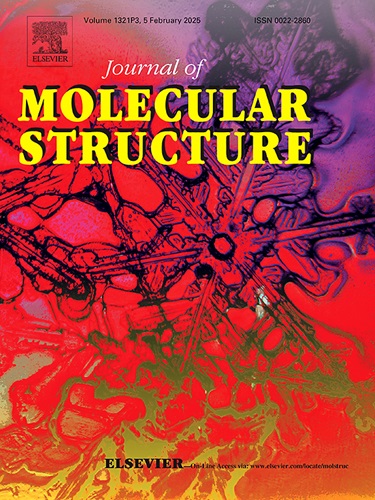Structural characterization and spectroscopic analysis of NIR emitting LiBi(MoO4)2:Ln3+(Ln= Nd, Yb and Er) phosphors for optical applications
IF 4
2区 化学
Q2 CHEMISTRY, PHYSICAL
引用次数: 0
Abstract
Results on luminescence in near infrared (NIR) region of the lanthanide ions as an activator in LiBi(MoO4)2 host synthesized by solid state reaction are presented. The samples were characterized using x-ray diffraction, electron microscopy, energy dispersive spectra, elemental mapping, Raman, FTIR and luminescence spectroscopy. Symmetric and asymmetric stretching vibrations of (MoO42−), were identified through combined Raman and FTIR studies. LiBi(MoO4)2 crystalises in non-centrosymmetric space group (I-4). Nd3+, Yb3+ and Er3+ were used as activators. They yielded emission lines at 1066, 1005 and 1541 nm, respectively. Yb3+ emission was observed only upon sensitization by Nd3+. Lifetime measurements were used for calculating the energy transfer efficiency which was about 83.5 %. Bandgap of LiBi(MoO4)2 was calculated as 3.32 eV from Tauc’s plot. This phosphor has potential applications related to NIR.
光学用近红外发光LiBi(MoO4)2:Ln3+(Ln= Nd, Yb和Er)荧光粉的结构表征和光谱分析
研究了镧系离子作为活化剂在固相合成LiBi(MoO4)2基质中的近红外发光特性。采用x射线衍射、电子显微镜、能量色散光谱、元素图、拉曼光谱、红外光谱和发光光谱对样品进行了表征。(MoO42−)的对称和非对称拉伸振动通过拉曼和FTIR研究进行了识别。LiBi(MoO4)2在非中心对称空间群(I-4)中结晶。用Nd3+、Yb3+和Er3+作为活化剂。它们分别在1066、1005和1541 nm处产生了发射线。仅在Nd3+敏化后才观察到Yb3+的发射。用寿命测量法计算了能量传递效率,约为83.5%。根据Tauc图计算LiBi(MoO4)2的带隙为3.32 eV。该荧光粉具有与近红外相关的潜在应用。
本文章由计算机程序翻译,如有差异,请以英文原文为准。
求助全文
约1分钟内获得全文
求助全文
来源期刊

Journal of Molecular Structure
化学-物理化学
CiteScore
7.10
自引率
15.80%
发文量
2384
审稿时长
45 days
期刊介绍:
The Journal of Molecular Structure is dedicated to the publication of full-length articles and review papers, providing important new structural information on all types of chemical species including:
• Stable and unstable molecules in all types of environments (vapour, molecular beam, liquid, solution, liquid crystal, solid state, matrix-isolated, surface-absorbed etc.)
• Chemical intermediates
• Molecules in excited states
• Biological molecules
• Polymers.
The methods used may include any combination of spectroscopic and non-spectroscopic techniques, for example:
• Infrared spectroscopy (mid, far, near)
• Raman spectroscopy and non-linear Raman methods (CARS, etc.)
• Electronic absorption spectroscopy
• Optical rotatory dispersion and circular dichroism
• Fluorescence and phosphorescence techniques
• Electron spectroscopies (PES, XPS), EXAFS, etc.
• Microwave spectroscopy
• Electron diffraction
• NMR and ESR spectroscopies
• Mössbauer spectroscopy
• X-ray crystallography
• Charge Density Analyses
• Computational Studies (supplementing experimental methods)
We encourage publications combining theoretical and experimental approaches. The structural insights gained by the studies should be correlated with the properties, activity and/ or reactivity of the molecule under investigation and the relevance of this molecule and its implications should be discussed.
 求助内容:
求助内容: 应助结果提醒方式:
应助结果提醒方式:


